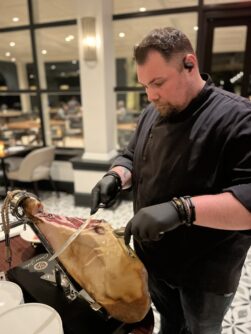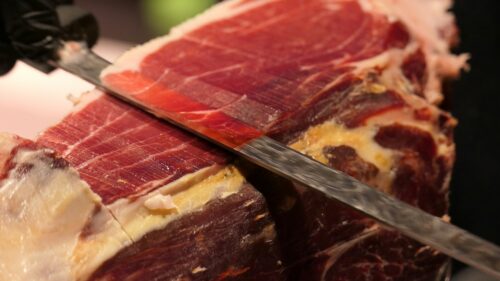Iberico ham, or jamón ibérico, is one of Spain’s most celebrated gastronomic delights, renowned for its complex flavor, delicate texture, and deep cultural roots. This cured ham, produced on the Iberian Peninsula, is a symbol of Spanish culinary tradition, crafted over centuries. Iberico ham’s unique quality and rich history make it a must-try for food enthusiasts seeking an authentic taste of Spain.

Origins and Tradition
The story of Iberico ham begins with the Iberian pig (Cerdo Ibérico), a native breed that has roamed the dehesa (oak forests and pastures) of southwestern Spain and Portugal for thousands of years. These pigs, distinguishable by their black skin and slender limbs, are the source of the ham’s signature flavor. What sets them apart is their ability to store fat within their muscle tissue, which gives the ham its marbled texture and rich taste.
Iberico ham production is steeped in tradition and follows strict regulations to preserve its authenticity and ensure premium quality. A major factor in its exceptional flavor is the pigs’ diet. In the last stage of their life, the pigs roam freely in the oak forests, feeding on acorns (bellota) rich in oleic acid. This acorn diet imparts a nutty, earthy flavor to the ham, while the pigs’ exercise helps develop the ham’s fine texture.
Recently, chef Tom Gloster of The Union in East Meadow introduced dining patrons to Iberico ham, offering samples of the delicacy.
“The flavor is rich and the animals’ care is meticulous and so traceable,” Gloster said. “You know exactly when the animal was born, what it was fed and how it was raised; it is the pinnacle of cured meats.”
For Gloster, Iberico ham stands out not just for its traceability, but also for its unparalleled flavor. It’s a specialty he’s excited to offer and a reminder of the value of knowing exactly where your food comes from.
The Production Process
The production of Iberico ham is a meticulous process that can take several years. After the pigs are slaughtered, their legs are salted and left to cure. This removes moisture, preserving the meat and intensifying its flavor. Once salted, the legs are hung to dry in ventilated curing rooms where they are exposed to the changing seasons. This curing process, which lasts anywhere from 24 to 48 months, allows the flavors to develop slowly.
As the fat breaks down, it infuses the meat, enhancing its flavor. The longer the curing period, the richer and more complex the taste becomes, resulting in a ham that is both savory and sweet, with hints of herbs, nuts, and fruits.
Types of Iberico Ham
Not all Iberico ham is the same. The quality and flavor depend on the pigs’ diet and their percentage of Iberian heritage. The four main classifications are:
- Jamón Ibérico de Bellota: The finest and most expensive variety, these pigs are fed an acorn-rich diet and roam freely in oak forests. This gives the ham a buttery texture and rich, nutty flavor, with high marbling that makes it melt in your mouth.
- Jamón Ibérico de Cebo de Campo: These pigs have a mixed diet of acorns and grains, with some access to pasture. While still flavorful, this variety is less intense than Bellota ham.
- Jamón Ibérico de Cebo: Pigs raised on grains and legumes, with little or no access to pasture, produce this milder ham. While still high-quality, it lacks the complexity of Bellota hams.
- Jamón Ibérico 100%: This classification is reserved for purebred Iberian pigs, with no crossbreeding. Pure Iberico pigs offer a more concentrated flavor.
Tasting and Serving Iberico Ham
Tasting Iberico ham is a refined experience. Each bite reveals layers of flavor, starting with a salty tang followed by a lingering sweetness. The fat melts at room temperature, coating the palate with a silky smoothness, while the meat itself is tender and almost buttery.

To fully appreciate its delicate texture and taste, Iberico ham is traditionally served in thin, hand-carved slices. It should be served at room temperature so the fat softens just enough to release its full flavor. In Spain, it is often enjoyed as part of a tapas spread, paired with crusty bread, olives, and a glass of sherry or red wine. Its bold flavor complements other dishes without overpowering them.
Global Appeal
While Iberico ham has long been a staple of Spanish cuisine, its fame has spread worldwide. Today, it is a coveted delicacy in gourmet markets and upscale restaurants around the globe. The scarcity of Iberico ham and the labor-intensive production process contributes to its high price, making it a luxury item for many.
Despite its cost, Iberico ham continues to captivate food lovers with its exceptional flavor and artisanal craftsmanship. For those who value authenticity and quality in their food, Iberico ham offers a taste experience like no other. Whether enjoyed as part of a traditional Spanish meal or on its own, it is a testament to Spain’s rich culinary heritage.
Iberico ham is more than just cured meat; it is a symbol of Spain’s long-standing traditions and artisanal excellence. From the Iberian pigs that graze in oak forests to the artisans who meticulously cure each leg, every step in the process contributes to its exceptional quality. For those curious about the world of fine foods, Iberico ham offers a unique and flavorful journey into the heart of Spanish cuisine.































